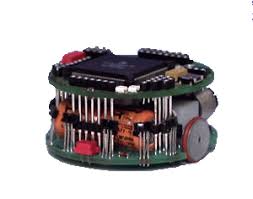The Khepera is a small  mobile robot developed at the EPFL (École polytechnique fédérale de Lausanne) by Prof. Jean-Daniel Nicoud and his team. The Khepera has been developed and manufactured as a commercial product by the K-Team Corporation, for use in education and research.
mobile robot developed at the EPFL (École polytechnique fédérale de Lausanne) by Prof. Jean-Daniel Nicoud and his team. The Khepera has been developed and manufactured as a commercial product by the K-Team Corporation, for use in education and research.
In Egyptian mythology, Khepera is the name of a beetle looking god, symbolizing the forces moving the sun. Khepera is more widely associated with “rebirth”, “resurrection”, “renewal”, and the general idea of “coming into being”: it might have inspired the looks and the name of the robot!
The main purpose of the Khepera is to provide a platform allowing training and experiments, involving local navigation, artificial intelligence, collective behavior, and real time programming.
The main purpose of the Khepera is to provide a platform allowing training and experiments, involving local navigation, artificial intelligence, collective behavior, and real time programming.
It is widely acknowledge that the Khepera played a non negligible part in the emergence of evolutionary robotics.
ORIGINAL VERSION
The original Khepera is a 55mm diameter and 3cm high robot, constructed around a 16 MHz Motorola 68331 processor. Its motion and steering is achieved via 2 DC brushed servo motors with incremental encoders, and obstacles are detected thanks to 8 infrared proximity and ambient light sensors. The robot can be remotely operated, as the previous Kheperas, via a Personal Computer.

Released 10 years ago, it has received a significant processor and firmware update before been discontinued. Let’s note that the sensors work pretty much like contact switches: the mobile robot could only detect very close obstacles.
K-2.0 VERSION
The Khepera II solved many shortcomings of the original, such as the reach of the distance sensors, swappable battery pack system for optimal autonomy, and a better differential drive odometry, allowing more precision on awkward surfaces. The khepera is now also capable of embarking additional modules increasing the versatility of the system. However, the most notable improvement is the added processing power improving the robot’s computing autonomy.
K-3.0 VERSION
The third iteration of the Khepera is almost a revolution from the hardware point of view. On top of an array of 9 infrared sensors, two ground oriented sensors allowing line following and edge detection, the Khepera also embarks five ultrasonic sensors.
An additional module allows Linux support, Flash extension cards, Wi-Fi, Bluetooth, 2D cameras, and extra storage space to complete the Khepera’s arsenal. The mobile robot also provides the user with improved quality motors and odometers to work with.
KHEPERA, PROGRAMMING AND CONTROL
Remote operation programs can be written with Matlab, LabView, or with any programming language supporting serial port communication. Here are the interesting ones;
#.1. KiKS
#.1. KiKS
KiKS means "KiKS is a Khepera Simulator", and runs under Matlab. It was developed by Theodor Storm as a Master’s degree year long project. KiKS emulates one or more Khepera robots connected to the computer by simulating motors, proximity/light sensor, and behaviours.
#.2. KHEPERA SIMULATOR
Khepera Simulator is a freeware package allowing to develop controllers for the mobile robot Khepera using C or C++ languages. It includes an environment editor and a graphical user interface. Moreover, if you own a Khepera robot, you will be able to switch very easily between the simulated robot and the real one. It is mainly directed at teaching and research in autonomous agents.
#.3. KHEPERA IN PLAYER/STAGE








No comments:
Post a Comment